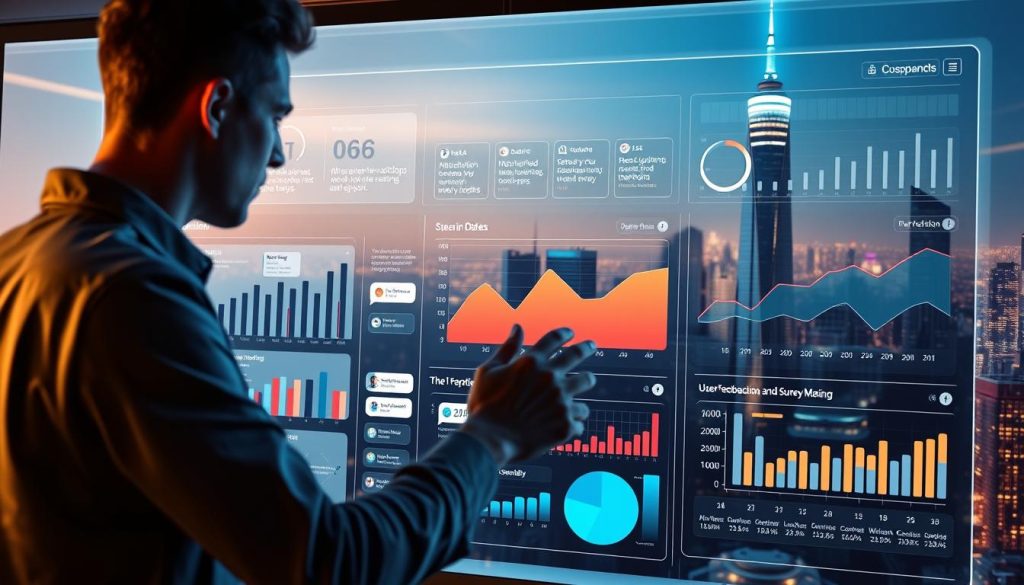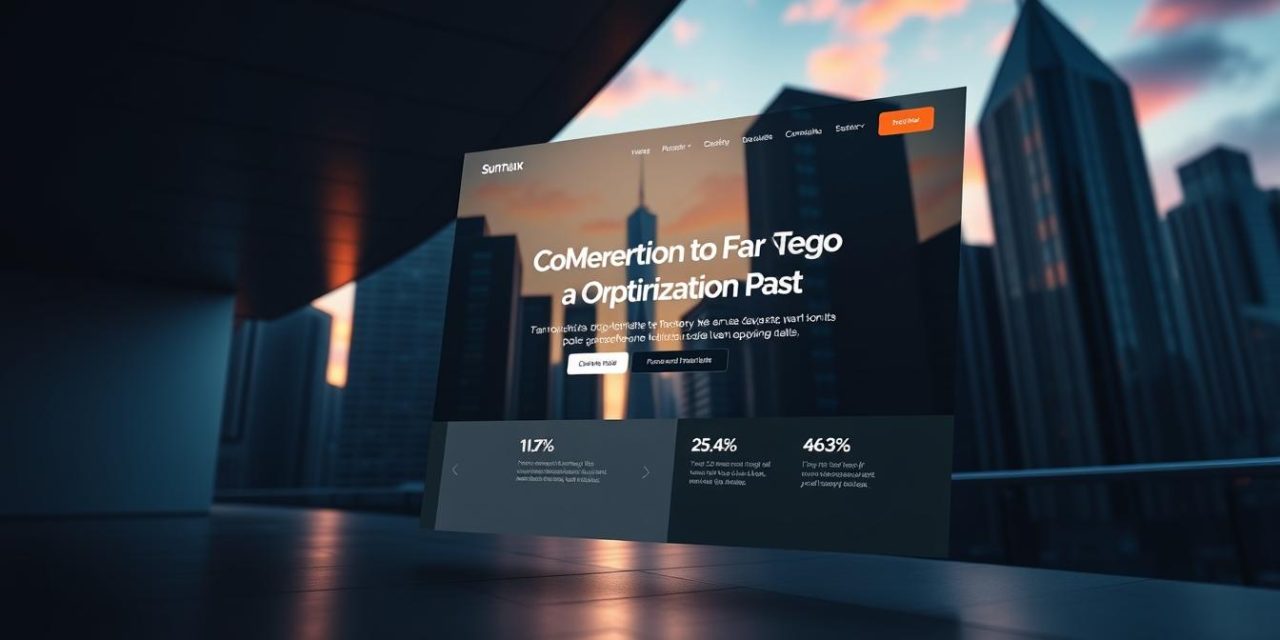Welcome! Your website is a powerful tool for your business. But are you making the most of it? When people click on your ads or links, where do they go? This first stop is crucial.
We’re talking about the art and science of making that first impression count. It’s about systematically improving every element to guide your visitors toward a clear goal. This process turns casual browsers into valuable leads and customers.
Think of it as creating a smooth, welcoming path. You remove confusion and friction. You highlight benefits and make the next step obvious. The result? You see a real boost in your desired actions, or conversions.
This guide is your friendly introduction. We’ll break down the core concepts into simple, actionable steps. You’ll learn what works, what doesn’t, and how to apply these strategies to your own site for better results.
Table of Contents
Key Takeaways
- Landing page optimization is a systematic process to improve performance.
- The main goal is to increase conversions from your website visitors.
- It involves making data-driven changes to design, copy, and calls-to-action.
- A well-optimized page creates a clear path for visitors to follow.
- Effective optimization can significantly improve your marketing return on investment.
- This guide provides actionable steps you can implement right away.
Introduction to Landing Page Optimization
Have you ever considered the true power of that first digital handshake with a potential customer? This initial encounter often happens on a specialized landing page. It’s your chance to make a fantastic impression.
So, what exactly is this process? It’s a focused effort to enhance every part of that crucial stop.
Landing page optimization is the process of improving various elements to achieve the highest possible conversions from arriving visitors. It’s a key part of Conversion Rate Optimization (CRO).
Understanding the Basics
This approach is very different from general website design. A standard site has many goals. A targeted landing page has just one clear objective.
Every single element—the headline, the image, the form—must work together. They guide your visitors smoothly toward one desired action.
| Feature | Standard Webpage | Optimized Landing Page |
|---|---|---|
| Primary Goal | Inform, entertain, multiple actions | Single, specific conversion |
| Navigation | Complex menus, many links | Minimal, focused on one path |
| Content Focus | Broad company information | Specific offer or message |
Why Optimization Matters for Your Website
The impact on your business is direct. Even a small improvement can lead to a significant revenue increase. This is especially true when you pay for traffic.
Many companies waste money sending clicks to underperforming pages. A few smart changes to your effective landing pages can double your conversion rates. You get more value from your existing ad spend.
It’s not just about aesthetics. It’s a strategic, data-driven way to turn more visitors into leads. This foundation sets the stage for deeper strategies ahead.
Landing Page Optimization: Definition and Significance
Many businesses focus heavily on attracting clicks but overlook what happens after people reach their destination. This systematic refinement process transforms casual visitors into committed customers.
What It Means for Your Business
For your company, this approach means maximizing every marketing dollar. When your digital entry points perform better, you acquire customers at lower costs.
The same traffic generates more revenue. You create a smoother path from interest to action, making your marketing investments more efficient.
The Impact on Conversion Rates
The effect on your conversion numbers can be dramatic. Companies committed to this process often see improvements of 50% or more.
Campaigns that were barely profitable can become significant revenue generators. This focus removes obstacles that prevent visitors from taking desired actions.
You guide people naturally toward becoming loyal customers while driving meaningful business results.
When to Use a Landing Page
Timing is everything when it comes to choosing the perfect digital entry point for your marketing efforts. Knowing when to deploy a specialized destination can dramatically improve your campaign results and maximize your return on investment.

Strategic placement of focused digital spaces makes a significant difference in conversion rates. The key is understanding which scenarios demand a targeted approach versus a general website visit.
Campaign-Specific Strategies
Different marketing channels require tailored approaches. When you’re driving paid traffic from sources like Google Ads or social media, a dedicated destination ensures message consistency.
Creating separate spaces for each traffic source allows for better testing and optimization. You can customize the experience based on where your visitors are coming from.
| Campaign Type | Best Approach | Key Benefit |
|---|---|---|
| Paid Advertising | Dedicated landing page | Maximizes conversion from paid traffic |
| Email Marketing | Customized landing page | Matches email content perfectly |
| Social Media Campaigns | Platform-specific page | Appeals to specific audience demographics |
| Time-Sensitive Offers | Standalone landing page | Quick deployment and easy removal |
Alternative Use Cases and Promotions
Beyond standard advertising campaigns, these focused spaces work wonderfully for special events and product launches. They provide a clean, distraction-free environment for specific actions.
Quick promotional needs benefit greatly from standalone pages. They bypass complex website updates and get your message out faster.
Testing new concepts becomes safer with dedicated spaces. You can experiment without affecting your main site’s performance or brand consistency.
Pre-Design Considerations for Landing Pages
The foundation of any effective online destination lies in thorough pre-planning and research. Before designing begins, you must understand both your business goals and your visitors’ needs.
Identifying Your Target Audience
Knowing your target audience is essential. Go beyond basic demographics to understand their real challenges and motivations.
Create detailed user personas to visualize exactly who you’re addressing. This helps craft messaging that resonates with specific people rather than trying to appeal to everyone.
Consider where your visitors are in their buying journey. Someone new to your product needs different information than someone ready to purchase.
Aligning Campaign Objectives with User Needs
Find the sweet spot where your business goal meets what your audience seeks. This creates a win-win situation.
Research technical details like device usage and browser preferences. These factors influence how you design your page for the best experience.
Review past campaign performance and competitor approaches. Learn from what works to create better landing pages that convert effectively.
Best Practices for Landing Page Design
The visual and structural elements of your online entry point play a crucial role in visitor engagement. Getting these fundamentals right can dramatically improve how people interact with your content.
Maintaining Message Match Throughout the Page
Consistency is key when someone arrives from an ad or email. The experience should feel like a natural continuation of what brought them there.
This means keeping the same tone, visuals, and messaging. When everything aligns, people feel more comfortable taking the next step.
Visual Appeal and Clean Layouts
First impressions matter greatly in the digital space. A clean, professional appearance builds immediate trust with your audience.
Use white space effectively to highlight important elements. Guide the eye toward your main goal without distractions.
Every component should serve a purpose in moving visitors toward conversion. Remove anything that doesn’t support this objective.
The Role of Copy and Headline Optimization
The words you choose can make or break your visitor’s journey in an instant. Your headline is the first thing people see. It must grab attention and communicate value immediately.
Think of your main title as the welcome mat. It sets the tone for the entire experience. If it’s unclear or uninteresting, people will leave before reading further.
Crafting Compelling Headlines
You have mere seconds to convince someone your content is worth their time. Your headline needs to be crystal clear and benefit-focused. It should directly relate to what brought them to your page.
The best copy is concise and gets straight to the point. Respect your visitors‘ time by communicating your core message quickly. Avoid making people wade through paragraphs before understanding your offer.
Effective headlines often use numbers, ask questions, or create curiosity. They speak directly to your audience’s needs and desires. This emotional connection is more persuasive than just listing features.
Supporting text elements like subheadings and bullet points make your content easier to scan. Most people skim rather than read every word. Proper formatting helps them find relevant information faster.
Remember, the goal isn’t just to sell. It’s to establish a connection that persuades action. Testing different versions of your landing page copy helps discover what resonates best with your specific audience.
Enhancing Trust with Social Proof
One of the most effective ways to build immediate trust is through the power of social validation. When visitors see that others have already benefited from your offerings, their hesitation often transforms into confidence.
This psychological principle works because people naturally look to others for guidance. Seeing positive experiences from real customers creates a sense of safety and reliability.
Leveraging Testimonials and Reviews
The most powerful social proof comes from authentic testimonials. Choose feedback that matches your target audience’s profile. Specific details like names and company affiliations make testimonials feel genuine.
Video testimonials add an extra layer of credibility. They let visitors see and hear real experiences. This human connection is harder to fake than written text.
Strategic placement of these elements throughout your landing page is crucial. Position them near key decision points to overcome objections. This builds confidence right when people need reassurance.
Trust badges and security seals provide additional validation. They reassure visitors that their personal information is safe. This is especially important for business transactions requiring sensitive data.
Beyond testimonials, consider showcasing customer logos or media mentions. These visual indicators demonstrate broader acceptance. They show that respected organizations trust your brand.
Optimizing Call to Action for Conversions
That final click is everything. It’s the moment a casual browser becomes a committed customer. Getting this element right is non-negotiable for success.
Your call to action is the bridge between interest and action. It must be clear, compelling, and impossible to miss.
Designing Effective CTA Buttons
Think of your button as a beacon. It needs to stand out visually. Use a contrasting color that pops against your background.
Size matters, too. Ensure it’s large enough to tap easily on any device. The text should be short and action-oriented.
Phrases like « Get Started » or « Claim Your Offer » work better than vague words. They tell visitors exactly what happens next.
Testing CTA Placement and Messaging
Where you put your button is just as important as its design. The best spot can vary. Some sites perform better with the main action above the fold.
Longer content often benefits from multiple buttons. Place them where people naturally pause. Testing different positions helps you find the sweet spot.
Try first-person phrasing like « Start My Trial. » It often increases conversion rates. Always leave ample white space around the button to make it the focal point.
Mobile-First Landing Page Strategies
With mobile devices dominating internet usage, your approach to digital experiences must prioritize small screens. More than half of all web traffic now comes from smartphones. This makes mobile-first thinking essential for success.

People interact differently on phones than computers. They multitask more and have less patience for slow loading. Your content needs to adapt to these behaviors.
Ensuring Responsive Design
Responsive design means your content works on any device. But mobile-first means starting with the smallest screens first. This approach forces you to focus on what matters most.
Touch-friendly elements are crucial for mobile users. Buttons must be large enough for thumbs. Forms should minimize typing requirements.
Load speed becomes critical on mobile connections. Optimize images and reduce unnecessary code. Every second counts when people are on the go.
Test your pages on actual devices, not just simulators. Real phones reveal issues that computers might miss. This ensures a smooth experience for all visitors.
Conversion Rate Optimization Techniques
The real magic happens when you stop assuming and start testing. Instead of guessing what might work, you use actual visitor behavior to guide your improvements.
This approach transforms your digital strategy from subjective opinions to objective results. You build a systematic process for continuous enhancement.
A/B Testing and Data-Driven Design
A/B testing is your most powerful tool. You create two versions of your content with one key difference. Then you show each version to similar groups of visitors.
The data reveals which variation performs better. This method eliminates guesswork and personal bias. You make decisions based on what real users actually do.
Start with simple tests like button colors or headline changes. As you gain confidence, experiment with more complex elements. Each test builds your knowledge base.
Utilizing Analytics for Continuous Improvement
Your analytics platform is a goldmine of insights. It shows you exactly how people interact with your content. Look for patterns in user behavior.
Identify where visitors drop off or hesitate. These friction points are opportunities for improvement. Form hypotheses about what changes might help.
The process never truly ends. There’s always another element to test and refine. This commitment to gradual enhancement yields significant long-term results.
Landing Page SEO for Increased Traffic
What if your carefully crafted landing page could continue generating valuable traffic long after your paid campaigns end? This is the power of search engine optimization. Many people focus solely on paid channels, but organic search brings sustained visitors without additional costs.
Optimizing your content for search engines ensures long-term visibility. People discover these pages through natural search results daily. This boosts your conversion rates and engagement metrics over time.
Keyword Integration and Meta Optimization
Start by researching terms your audience uses when seeking solutions. Incorporate these keywords naturally into your headlines and body text. Avoid awkward stuffing that disrupts reading flow.
Your title tags and meta descriptions serve as mini-advertisements in search results. They should include target keywords while enticing clicks. A compelling description can significantly improve your click-through rate.
Don’t overlook technical elements like header tags and image alt text. These contribute to how well your content ranks. Clean URLs with primary keywords help both search engines and users understand your page’s purpose.
Remember that speed and mobile-friendliness are critical ranking factors. A slow or poorly formatted site will struggle regardless of keyword quality. Proper on-page optimization creates a foundation for organic success.
The beauty of this approach is its compounding effect. Once you achieve good rankings, you’ll receive free traffic indefinitely. This makes SEO a valuable complement to any advertising strategy.
Integrating User Feedback and Data
Imagine being able to watch over your visitors’ shoulders as they interact with your content. This insight transforms guesswork into a science. You gain concrete information about what real people do on your digital spaces.

Using Heatmaps and Session Replays
Heatmaps are like x-ray vision into your audience’s behavior. They show exactly where people click, how far they scroll, and what captures their attention. Scroll maps reveal scroll depth. Click maps indicate interaction points.
Session replays let you watch actual visitor sessions. You see your content through their eyes as they navigate and hesitate. This helps identify specific friction points that need improvement.
User feedback collection through surveys provides the « why » behind the numbers. People can tell you in their own words what confused them or stopped them from converting. This qualitative data is gold.
The most effective strategies combine multiple data sources. Heatmaps show what visitors do. Session replays show how they do it. Surveys explain why they do it. This gives you a complete picture for refining your landing pages.
Don’t just collect information—act on it. Identify patterns, prioritize issues, and test solutions. This continuous improvement process leads to better performance over time.
Technical Considerations and Page Load Time
Behind every successful online interaction lies an often-overlooked factor that silently influences user behavior: the speed at which your content loads. Technical performance might not be as exciting as design, but it’s absolutely critical for keeping visitors engaged.
People today have little patience for slow-loading web content. If your site takes too long to display, they’ll simply hit the back button and move on to a competitor.
Improving Speed for Better UX
Start by measuring your current load time using free online tools. This gives you a baseline to track improvements. Even a one-second delay can reduce conversions by 7% or more.
Common issues include oversized images and excessive code. Image optimization is often the quickest win—compressing files and using modern formats can dramatically reduce load times.
Your hosting environment also matters significantly. Pages on slow servers will struggle regardless of how well-optimized your content is. Investing in quality hosting pays for itself through better performance.
Regular testing is essential, especially after adding new elements. Speed can degrade over time as you incorporate more features and integrations into your pages.
Leveraging AI and Automation in Optimization
Technology is now a game-changer for digital marketing. Artificial intelligence offers smart ways to enhance your site’s performance. It helps create a more personal experience for everyone who visits.
These tools use data to make real-time decisions. They show different content to different people. This approach goes beyond simple testing.
Personalizing the User Journey with AI
AI can tailor the experience based on a user’s behavior or source. It might change a headline or offer for someone on a mobile device. The system learns what works best over time.
Automation handles the heavy lifting of continuous testing. It allocates more traffic to winning variations without manual effort. This saves time and improves results.
The technology gets smarter as it collects more data. It identifies patterns much faster than a person could. This leads to better outcomes for your campaigns.
| Traditional Method | AI-Powered Approach | Key Advantage |
|---|---|---|
| Manual A/B Testing | Dynamic Personalization | Real-time adjustments |
| Fixed content for all | Tailored experiences | Higher engagement |
| Slow result analysis | Instant data processing | Faster improvements |
| One-size-fits-all | Segment-specific content | Better conversion rates |
Combining human insight with AI creates the most effective strategy. You focus on your audience while technology handles the optimization. This partnership drives the best performance for your digital presence.
Case Studies and Real-World Examples
Seeing real results from actual campaigns can be the best motivation for making changes to your digital presence. Concrete evidence shows what’s possible when you apply proven strategies.

Looking at successful campaigns provides valuable insights. You can learn from others’ experiences and apply similar approaches to your own efforts.
Success Stories from Leading Brands
Senior Performance Marketer Kayleigh Dibble achieved impressive results through systematic testing. Her team focused on improving their highest-traffic digital entry point.
They began by comparing a new design against the existing version. The updated layout featured cleaner visuals and simplified navigation.
The results were significant. The team saw a 24% reduction in cost-per-click and a 28% boost in conversion rates from the initial test.
When they applied these design principles to other digital properties, performance improved further. This demonstrates how successful strategies can scale across multiple campaigns.
| Metric | Before Changes | After Initial Test | After Scaling |
|---|---|---|---|
| Cost-Per-Click | Baseline | 24% Reduction | Further Improved |
| Conversion Rate | Baseline | 28% Increase | 66% Total Increase |
| Design Approach | Standard Layout | Cleaner Flow | Consistent Branding |
These examples show that small changes can create big impacts. Testing different elements helps identify what works best for your audience.
Every business can benefit from studying real-world success stories. They provide practical guidance for improving your own digital performance.
Conclusion
Your journey toward better digital performance doesn’t end with reading this guide—it’s just beginning. True landing page optimization is an ongoing process of learning and refinement. The most successful strategies evolve through continuous testing and adaptation.
By applying the best practices we’ve covered, you’ll create experiences that consistently convert more visitors into loyal customers. Remember to start small, focus on high-impact changes, and let data guide your decisions. Every improvement contributes to better conversion rates over time.
The time you invest in optimizing your digital presence will pay significant dividends. Start today by analyzing your highest-traffic page and forming one testable hypothesis. Your commitment to improvement is the great way to achieve lasting success with your landing strategy.
FAQ
What is the main goal of a landing page?
The primary goal is to guide visitors toward a single, specific action. This could be making a purchase, signing up for a newsletter, or downloading a resource. Everything on the page should support that goal.
How quickly can I expect to see results from optimizing my pages?
Results can vary, but you can often see improvements in conversion rates within a few weeks. The key is consistent testing and making small, data-backed changes over time.
Why is the headline so important?
Your headline is the first thing people read. A compelling headline grabs attention and clearly communicates your value proposition. It sets the tone for the entire visitor experience.
What is A/B testing and how does it help?
A/B testing involves showing two different versions of a page to users to see which one performs better. It helps you make informed decisions about design, copy, and calls to action based on real user data.
How can I make my call-to-action button more effective?
Use action-oriented text like « Get Started » or « Download Your Guide. » Make sure the button color contrasts with the page and test different placements to see what gets the most clicks.
What role does social proof play?
Social proof, like customer testimonials or trust badges, builds credibility. It shows new visitors that others have had a positive experience, which can ease concerns and increase conversions.
Is mobile design really that critical?
Absolutely! A huge portion of web traffic comes from mobile devices. If your site isn’t easy to use on a phone or tablet, you could be turning away a large segment of your potential audience.
How do I know if my changes are working?
Use analytics tools to track key metrics like bounce rate, time on page, and most importantly, your conversion rate. This data tells you what’s resonating with your audience.





